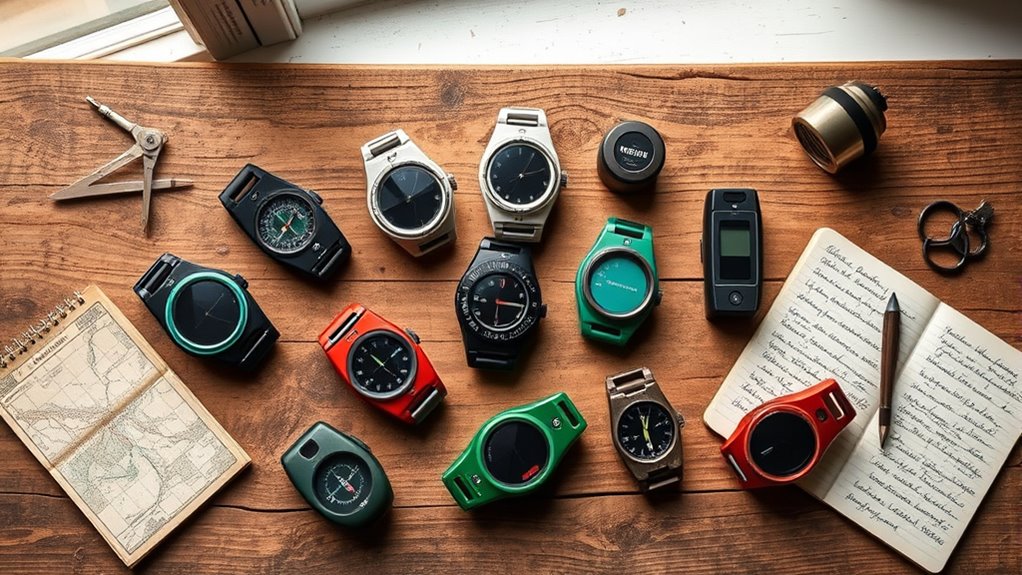As a budget-conscious explorer, I’m thrilled to share my top picks for affordable geophones that won’t empty your wallet. These devices deliver reliable performance, portability, and durability—perfect for outdoor adventures. I’ve considered factors like sound quality, ease of use, and sensitivity to guarantee you get the best value. With the right choice, you can confidently explore without overspending. Stick around, and you’ll discover more details about each recommendation!
Key Takeaways
- Establish a clear budget and prioritize essential features to find the best geophones that fit your financial needs.
- Select geophones with high sound quality and minimal distortion for accurate seismic data collection.
- Look for lightweight, portable designs made from durable materials for easy transport and long-term use.
- Choose models with high waterproof ratings and shock-absorbing casings for outdoor durability and reliability.
- Ensure ease of use with straightforward setup instructions and intuitive controls for efficient operation in the field.
Motorola Moto g Play 2024 Smartphone (Tracfone)
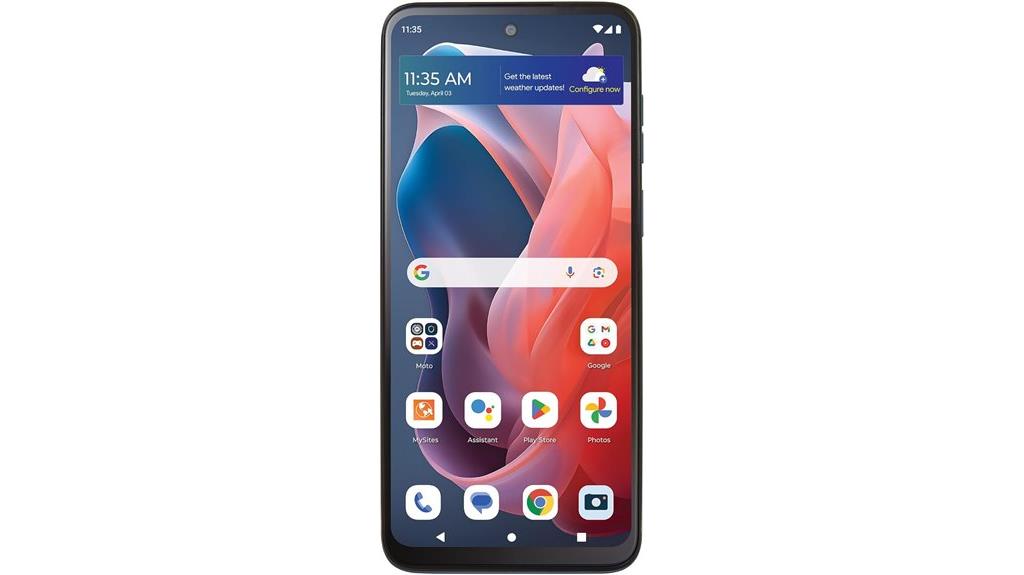
If you’re someone who values functionality without breaking the bank, the Motorola Moto g Play 2024 Smartphone from Tracfone is an excellent choice. With 64GB of storage that can expand to 1TB, I never worry about running out of space for my photos or apps. The 5000mAh battery lasts an impressive 46 hours, keeping me connected throughout my day. I love the 6.5-inch HD+ display and the 50MP camera, which captures stunning nighttime shots. Plus, it’s lightweight and easy to set up. Overall, it’s a reliable device that fits my budget and meets my everyday needs perfectly.
Best For: Budget-conscious users who need a reliable smartphone for everyday functions and media consumption.
Pros:
- Good storage capacity with the option to expand up to 1TB.
- Long-lasting 5000mAh battery providing up to 46 hours of usage.
- Lightweight design and easy setup make it user-friendly.
Cons:
- Some users experience lag during animations.
- Preloaded apps can take up storage space.
- Skepticism regarding the quality of the camera despite the high megapixel count.
TracFone Moto g Pure (2021) Prepaid Smartphone
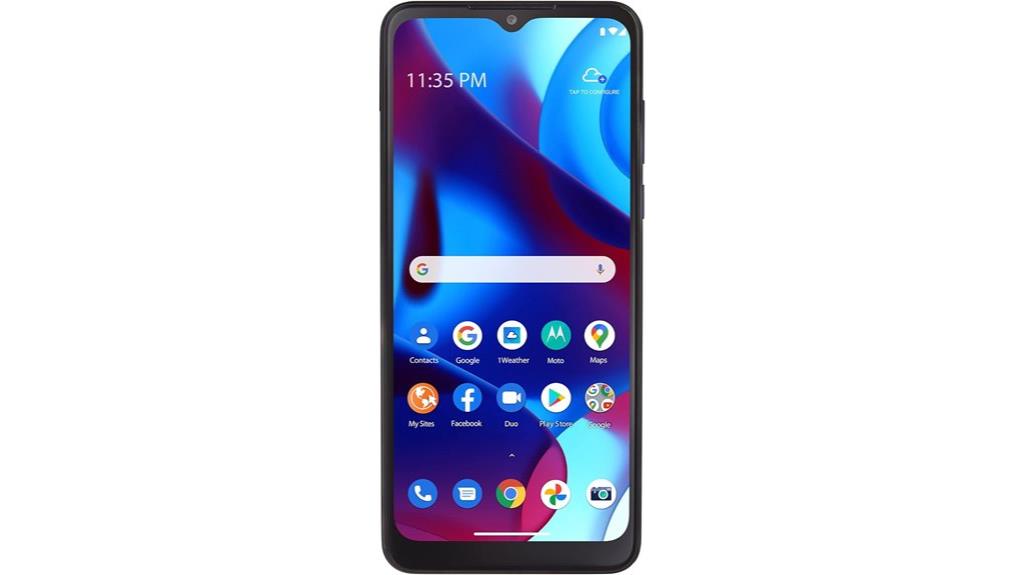
For those seeking an affordable yet reliable smartphone, the TracFone Moto g Pure (2021) stands out with its impressive battery life, lasting up to two days on moderate use. Weighing just 12.6 ounces and featuring a sleek 6.5” Max Vision HD+ display, it’s perfect for streaming and browsing. With a dual camera system, you can capture great photos, while the octa-core processor guarantees smooth performance. Plus, its water-repellent design makes it ideal for outdoor adventures. Although the 32GB storage might require an SD card for extensive use, it’s a fantastic value for the price, rated 4.3 stars by users.
Best For: Those seeking an affordable smartphone with long battery life and reliable performance for everyday use.
Pros:
- Impressive battery life lasting up to two days on moderate use.
- 6.5” Max Vision HD+ display for an enhanced viewing experience.
- Water-repellent design suitable for outdoor activities.
Cons:
- Limited 32GB storage may require an SD card for extensive use.
- Locked to Tracfone network, restricting carrier options.
- Performance may not meet the needs of heavy users or gamers.
TracFone Motorola Moto g Play Smartphone
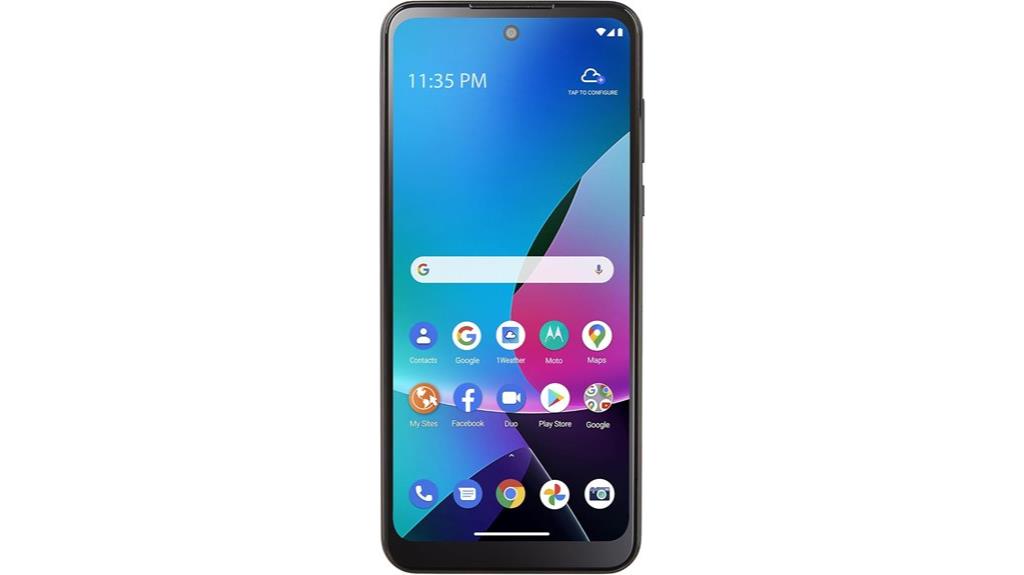
The TracFone Motorola Moto g Play Smartphone stands out with its impressive 5000mAh battery, making it perfect for budget-conscious explorers who need a reliable device for their adventures. With a vibrant 6.5-inch display and a 16MP triple camera system, capturing memories is a breeze. I love that it lasts up to three days on a single charge, so I don’t have to worry about running out of power. Plus, with easy activation on Tracfone and affordable plans starting at just $20 a month, it’s an excellent choice for anyone wanting functionality without breaking the bank.
Best For: Budget-conscious users looking for a reliable smartphone with excellent battery life and camera capabilities.
Pros:
- Great battery life lasting up to three days on a single charge.
- Good camera quality with a 16MP triple camera system.
- Affordable no-contract plans starting at $20/month.
Cons:
- Performance can be laggy when using multiple apps simultaneously.
- Not suitable for gaming due to limited processing power.
- Bluetooth connectivity issues have been reported by some users.
Gabb Phone 4: The Perfect First Phone for Kids
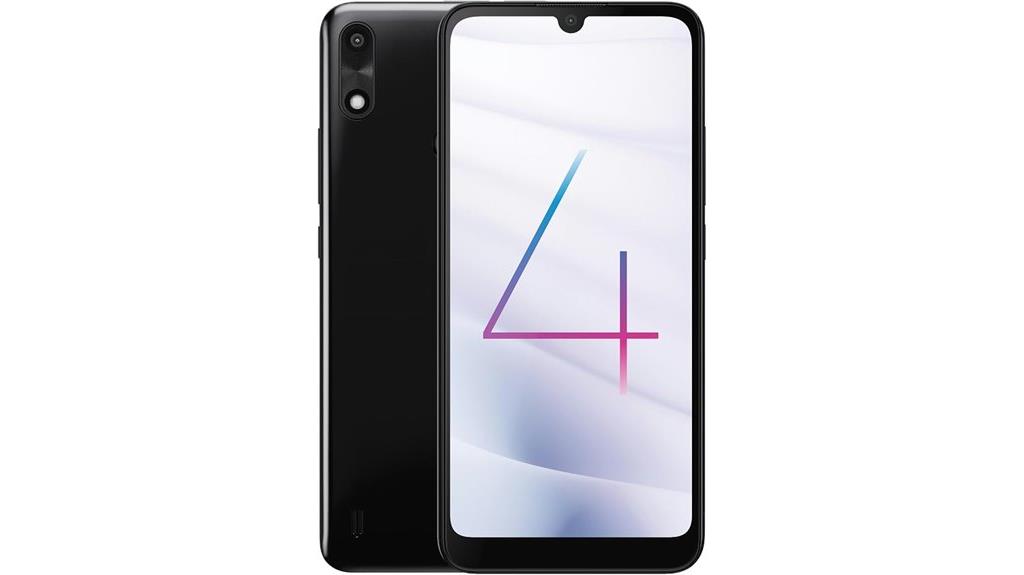
Looking for a safe and budget-friendly phone for your child? The Gabb Phone 4 is an excellent choice! Designed specifically for kids, it comes loaded with essential apps like Gabb Maps and Gabb Weather, while blocking social media and internet browsing. I love that Gabb Messenger filters messages, keeping communication secure. Plus, GPS tracking gives me peace of mind. Activation is straightforward, with no contracts, and the monthly plans are affordable. Despite some mixed reviews on battery life, it’s a great first phone for preteens, ensuring they stay connected without the risks of the online world.
Best For: The Gabb Phone 4 is best for parents seeking a safe and secure first phone for their preteen children.
Pros:
- Pre-loaded with essential apps and no access to social media or internet browsing.
- GPS tracking and Gabb Messenger filters for secure communication.
- Affordable monthly service plans with no contracts required.
Cons:
- Mixed reviews regarding battery life and performance issues.
- Some users report difficulties with customer service for support or replacements.
- Activation process may require extra steps if purchased as a gift.
Tracfone Motorola Moto g Pure, 32GB, Blue – Prepaid Smartphone (Locked)

If you’re after a budget-friendly smartphone that doesn’t skimp on essential features, the Tracfone Motorola Moto g Pure might just be what you need. With a 6.5-inch Max Vision HD+ display and a solid 4000 mAh battery, it keeps you connected without frequent recharging. The 32GB storage and 3GB RAM offer decent performance, ideal for basic tasks. Plus, its dual-camera system captures great photos. The water-repellent design adds durability, and the fingerprint sensor enhances security. Just remember, it’s locked to the Tracfone network, so you’ll need their SIM. Overall, it’s a reliable choice for anyone on a budget.
Best For: Budget-conscious users looking for a reliable smartphone for basic tasks and communication.
Pros:
- Affordable price with essential features for everyday use.
- Long-lasting 4000 mAh battery that supports up to 30 hours of talk time.
- Durable water-repellent design and secure fingerprint sensor for added protection.
Cons:
- Limited 32GB storage may not be sufficient for heavy users.
- Some users report lag in keyboard response and performance.
- Lacks advanced features like a headphone jack and tap and pay capabilities.
Parabolic Microphone Bird Listening Device

For anyone enthusiastic to immerse themselves in the enchanting world of birdwatching, the Parabolic Microphone Bird Monocular stands out as a top choice. Weighing just 1.48 pounds and measuring 2.56 x 7.28 x 2.56 inches, it’s lightweight and portable—perfect for outdoor adventures. Its low-energy design means you can enjoy prolonged listening without draining batteries. The sound quality impresses with less than 0.6% distortion, allowing for clear bird calls. While some users note construction concerns, many appreciate its affordability and effectiveness. Whether for yourself or as a thoughtful gift, this device makes nature observation even more engaging.
Best For: Nature enthusiasts and families interested in observing birds and wildlife.
Pros:
- Affordable and functional for casual birdwatching.
- Lightweight and portable design for easy transport during outdoor activities.
- Low energy consumption allows for extended use without frequent battery changes.
Cons:
- Some users report low-quality construction and durability issues.
- Headphone connectivity may present problems for certain users.
- Sound amplification may not meet the expectations for focused listening.
Geevon Water Leak Detectors (2 Pack)
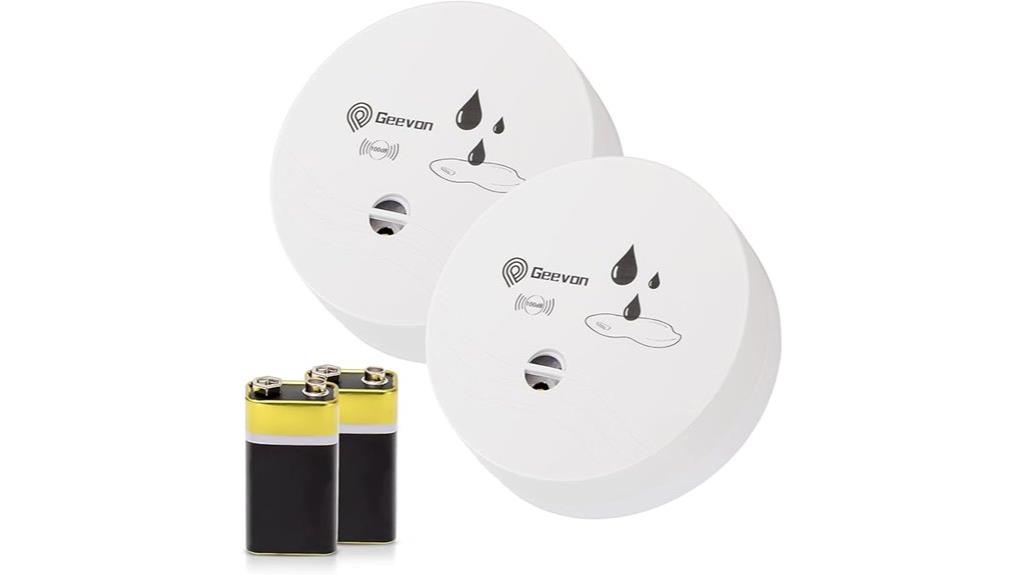
The Geevon Water Leak Detectors (2 Pack) are an excellent choice for homeowners seeking reliable protection against water damage without breaking the bank. These compact units feature a powerful 100dB alarm, ensuring you hear alerts throughout your home. I love that they’re easy to install—just insert the battery and place them near potential leak sources like sinks or water heaters. Their sensitive prongs accurately detect moisture, and their waterproof design gives me peace of mind. With a solid 4.5-star rating from nearly 2,000 users, they’re a trusted option for anyone wanting to safeguard their home effectively.
Best For: Homeowners looking for an effective and affordable solution to detect water leaks and prevent potential water damage.
Pros:
- Loud 100dB alarm alerts you to leaks throughout the house.
- Easy installation with no wiring required; simply insert the battery and place it in high-risk areas.
- Highly sensitive detection with waterproof design ensures reliable performance.
Cons:
- Some users feel the alarm volume could be louder for distant alerts.
- Battery replacement is needed every few years, which requires periodic maintenance.
- Limited functionality as it only detects water leaks and does not monitor other types of hazards.
Moen Smart Water Shutoff with Detector (1-Pack)
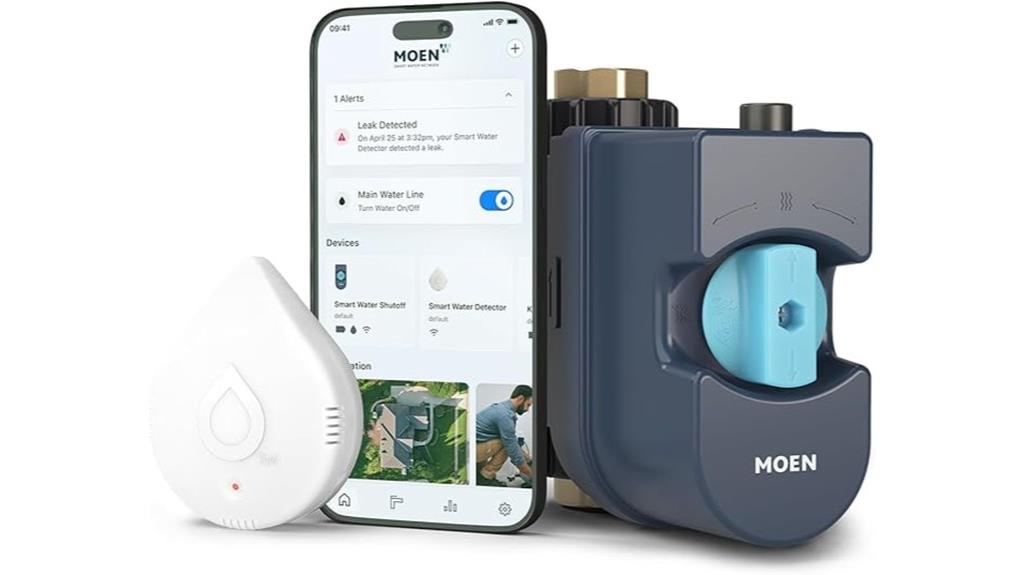
With 24/7 protection against water leaks, the Moen Smart Water Shutoff with Detector is an ideal choice for those who value peace of mind while being budget-conscious. This device monitors for even the tiniest leaks, preventing significant water damage over time. I love how it integrates with an app, allowing me to track water consumption and receive alerts on potential issues. Plus, the Smart Water Detector adds an extra layer of safety by notifying me of water presence in vulnerable areas. Installation’s quick, though I recommend a plumber. Overall, it’s a smart investment for any homeowner looking to safeguard their property.
Best For: Homeowners seeking peace of mind through proactive water leak detection and smart home integration.
Pros:
- 24/7 monitoring for leaks as small as one drop per minute, helping to prevent costly water damage.
- App integration allows for real-time tracking of water consumption and immediate alerts for any potential issues.
- Smart Water Detector enhances safety by notifying users of water presence in vulnerable areas.
Cons:
- Installation typically requires a professional plumber, which may add to the overall cost.
- Some users have reported issues with app functionality and customer service response times.
- Concerns about product reliability and limitations of warranty after replacement units.
Airthereal Water Leak Detector 3-Pack with WiFi Gateway
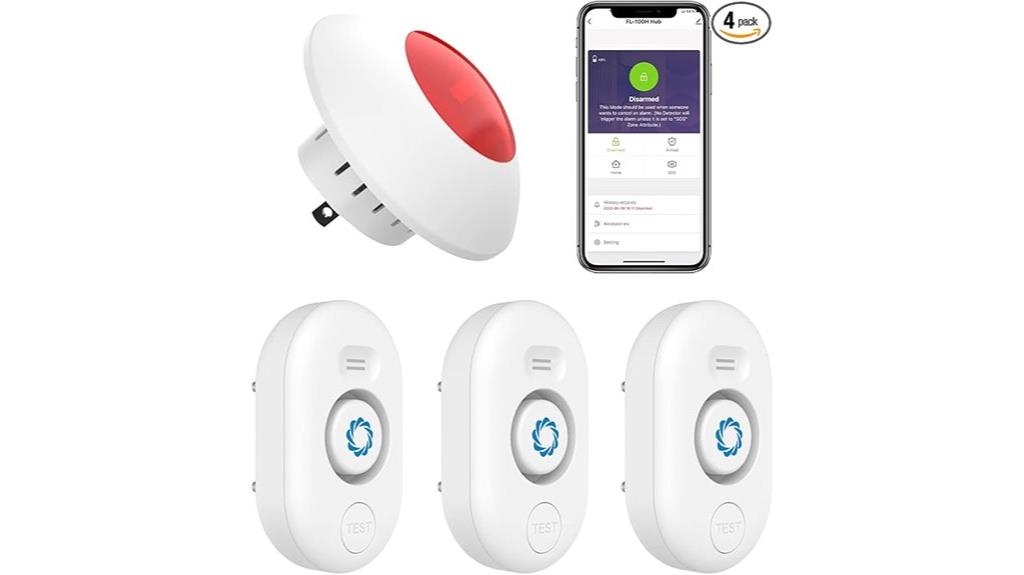
Airthereal’s Water Leak Detector 3-Pack shines as a must-have for homeowners keen on preventing water damage without breaking the bank. I appreciate the real-time alerts delivered through the AIRIA app, which connects easily via 2.4GHz WiFi. With an adjustable alarm volume up to 120dB, I can customize the alert to my preference. The ultra-sensitive probes guarantee I catch leaks early, especially in basements. Plus, the IP66 waterproof design means it’s durable in high humidity. While some users mention WiFi connectivity issues, the overall ease of setup and effectiveness makes this pack a practical choice for safeguarding my home.
Best For: Homeowners looking to prevent water damage, particularly in basements, with a reliable and budget-friendly solution.
Pros:
- Real-time alerts via the AIRIA app keep homeowners informed of any leaks instantly.
- Adjustable alarm volume allows customization to suit individual preferences, reaching up to 120dB.
- Durable design with an IP66 waterproof rating ensures long-lasting performance in high humidity areas.
Cons:
- Some users report WiFi connectivity issues, particularly with the app setup.
- App functionality can be inconsistent, leading to mixed experiences among users.
- Not compatible with 5G WiFi or Alexa, which may limit integration for some smart home setups.
Factors to Consider When Choosing Affordable Geophones
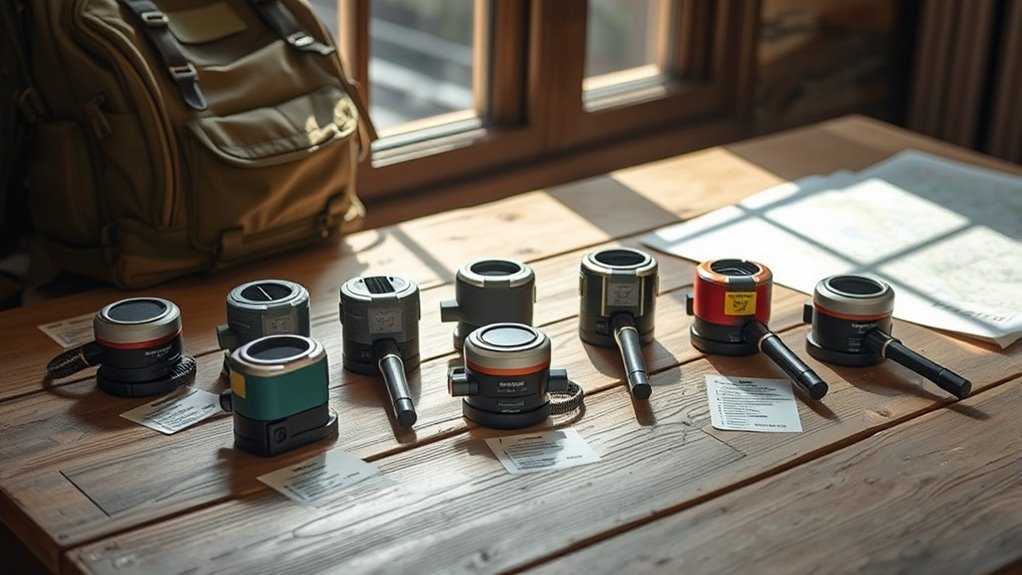
When choosing affordable geophones, I always consider my budget constraints first, since I want to get the best value. Sound quality is essential, but I also can’t overlook factors like portability and durability, especially if I’m using them outdoors. Finally, ease of use makes a big difference in how effectively I can gather data on my explorations.
Budget Constraints
Establishing a clear budget is essential if you’re looking to choose affordable geophones that meet your seismic monitoring needs. I recommend defining your budget based on the specific features you require. Don’t forget to factor in the cost of any additional accessories; these can add up quickly and impact your overall expenditure. As I’ve learned, researching and comparing prices from various suppliers can reveal the best deals while keeping you within budget. However, be cautious—lower-priced geophones might sacrifice sensitivity or frequency response, which can affect performance. Balancing cost with quality is vital; sometimes investing a bit more in a reliable geophone pays off in the long run, saving you money on replacements or repairs.
Sound Quality Importance
Sound quality is one of the top factors I consider when choosing affordable geophones. It directly impacts the clarity and accuracy of the seismic data, which is crucial for geological studies. I prefer geophones that reproduce sound with minimal distortion, ensuring that even subtle vibrations are captured accurately. A frequency response range from 1 Hz to 100 Hz is essential, as it allows detection of various seismic events, including low-frequency earthquakes. I also look for geophones with a sensitivity rating of at least 10 V/m/s, enhancing data quality. Additionally, the material and construction of the sensor matter; robust designs often provide better durability and performance in different environmental conditions, ultimately ensuring I get the best value for my investment.
Portability and Design
Portability is a game-changer for anyone selecting affordable geophones. I’ve found that lightweight and compact designs make a huge difference when I’m out in the field. Models made from durable materials are ideal, as they withstand outdoor conditions without adding unnecessary weight. Look for ergonomic grips and carrying cases that enhance mobility, especially during long sessions. A foldable or collapsible design can be a lifesaver when space is tight, allowing for easy storage and transport. Additionally, I can’t stress enough the importance of battery life and power management features. With effective power management, I’ve used my geophones for extended periods without the hassle of frequent recharging, making fieldwork far more enjoyable.
Durability for Outdoors
When I’m out in the field, the durability of my geophones is just as important as their portability. I always prioritize models with waterproof or water-resistant ratings, ensuring they can handle rain and humidity without faltering. I look for geophones made from durable materials like ABS plastic or reinforced metals to resist impacts and abrasions. A high IP rating, ideally IP67 or higher, gives me peace of mind against dust and temporary water submersion. Features like shock-absorbing casings or rubberized exteriors are essential for protecting against drops. Finally, I check user reviews or manufacturer specs to gauge how well the geophones perform under long-term outdoor conditions. Investing in durability means fewer worries while I explore.
Ease of Use
How do you know which geophones will be easy to use in the field? I look for models with straightforward setup instructions and user-friendly interfaces that let me deploy them quickly. It’s essential to choose geophones with intuitive controls and clear labeling, especially if I’m a first-time user. Some models even come with built-in tutorials or customer support resources, which can be a lifesaver when I’m figuring out the device’s functions. I also consider how accessible the data output options are, ensuring they work with common analysis software. Finally, I prefer geophones featuring visual indicators or displays, as they provide immediate feedback on performance, making the entire operation smoother and more efficient.
Sensitivity and Range
Choosing the right geophone goes beyond just ease of use; sensitivity and range play a significant role in ensuring you get accurate readings in the field. Sensitivity refers to a geophone’s ability to detect small vibrations, which means higher sensitivity helps identify subtle seismic waves that may be essential for your project. The range indicates how far these vibrations can be detected, influenced by the frequency of the seismic waves. Typically, lower frequencies are best for deep seismic activities, while higher frequencies suit shallow events. Keep in mind that factors like soil type and environmental conditions can affect performance. So, I recommend carefully considering sensitivity and range to match your specific geophysical study needs.
Frequently Asked Questions
What Is a Geophone and How Does It Work?
A geophone is a device I use to measure ground vibrations, often in exploration or seismic studies. It converts seismic waves into electrical signals, allowing me to analyze subsurface structures. When a wave hits, the geophone’s mass moves relative to its casing, generating a voltage that my equipment reads. This way, I can gather crucial data about the earth’s layers and potential resources, making it an essential tool for geologists and engineers alike.
Can Geophones Be Used for Personal Safety Applications?
Imagine having a magical device that can sense danger before you even see it! While geophones are primarily used for seismic activity, they could potentially enhance personal safety. I’ve thought about how they might detect vibrations from an approaching vehicle or even footsteps. However, they’re not designed for personal safety, so relying on them isn’t ideal. Still, it’s fascinating to think about the possibilities in enhancing our awareness of our surroundings!
How Do I Maintain My Geophone for Longevity?
To maintain my geophone for longevity, I regularly clean it after each use to remove dirt and debris. I also store it in a protective case, keeping it away from extreme temperatures and moisture. I check the cables and connections for wear and tear, replacing any damaged parts promptly. Finally, I follow the manufacturer’s guidelines for calibration and servicing, ensuring my geophone stays in top condition for all my explorations.
Are Geophones Waterproof or Weather-Resistant?
Geophones aren’t typically waterproof, but many are weather-resistant. I’ve used mine in various conditions, and I always make sure to protect it from heavy rain or moisture. It’s essential to check the specifications of your geophone model to understand its limits. If I know I’ll be in wet conditions, I bring along protective covers or bags to keep my equipment safe and functioning properly for longer. Always better to be safe than sorry!
What Is the Typical Lifespan of a Geophone?
When I think about the typical lifespan of a geophone, I usually find they last anywhere from 5 to 15 years, depending on the quality and usage conditions. I’ve noticed that factors like environmental exposure and handling can greatly affect their durability. If you take good care of them and store them properly, they’ll likely serve you well for many years. Regular maintenance can also help extend their lifespan even further.
Conclusion
In wrapping up this whirlwind of wallet-friendly wonders, I hope you’ve found the perfect pick for your geophone needs. From reliable reliability to remarkable results, these options offer excellent exploration without emptying your pockets. Remember, when choosing gear, consider compatibility, cost, and convenience. By making informed choices, you can commence your adventures confidently. So, plunge into discovery and delight in the durability of your new device—happy hunting, fellow explorers!
